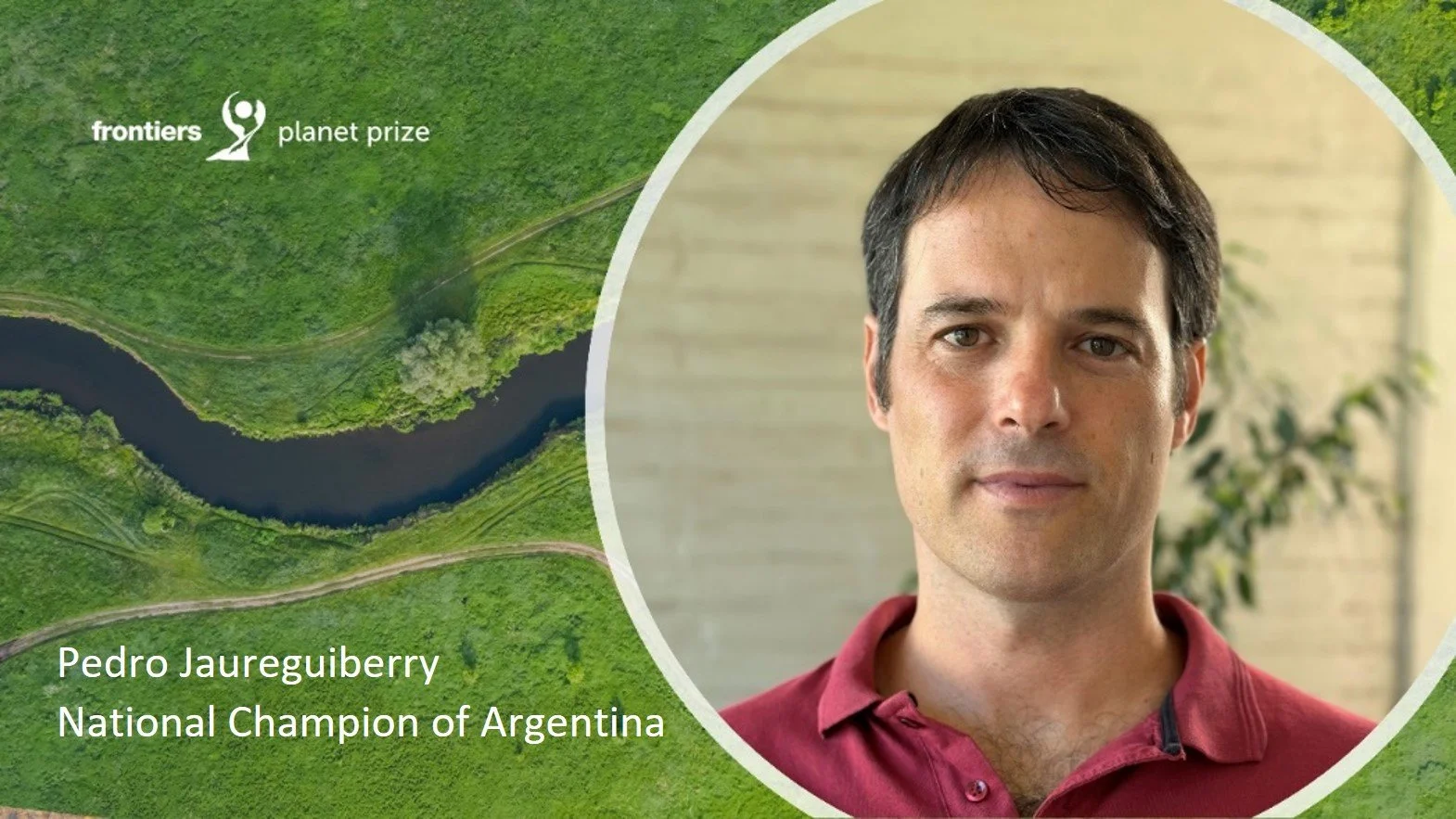Unraveling the Drivers of Biodiversity Loss: A Global Synthesis for Sustainable Action
Pedro Jaureguiberry
Instituto Multidisciplinario de Biología Vegetal (IMBIV), CONICET and Universidad Nacional de Córdoba, Córdoba, Argentina
“Our research’s insights on drivers of biodiversity loss are key to informing effective policies and for transformative action”
Human well-being relies on the intricate balance of ecological systems and the multiple benefits they provide to people. As our understanding of the interplay between human activity and nature deepens, concerns regarding human-driven impacts on the environment continue to escalate across scientific, political, and societal realms.
The main human pressures that directly influence biodiversity —henceforth, direct drivers— are climate change, direct exploitation of natural resources, invasive alien species, land/sea use change and pollution. Identifying which of these are causing more damage is fundamental for designing effective policies and setting actionable targets to address pressing sustainability challenges. Initiatives such as the post-2020 Global Biodiversity Framework (GBF) outlined by the Convention on Biological Diversity (CBD), and the Sustainable Development Goals (SDGs) established by the United Nations, underscore the critical need to pinpoint and mitigate these direct drivers.
The myriad ways in which human values and behaviors —the ultimate indirect drivers—contribute to biodiversity loss must, by definition, act through these direct drivers. Thus, any policy or action plan that fails to mitigate the direct drivers is inherently limited in its effectiveness, whatever effects they may have on indirect drivers earlier in the causal chain. Given this logic, it’s surprising that no one had previously nailed down which of the direct drivers has the greatest impact on the various dimensions of biodiversity—from genes and species to ecosystems.
Previous attempts to answer such question have either used expert judgment, focused on the analysis of one or a few indicators reflecting particular aspects of biodiversity or specific taxonomic groups (i.e., categories used to classify living organisms based on their similarities and evolutionary relationships), or considered only a subset of the main drivers. While all these approaches have all advanced knowledge, they can’t provide policy makers with the robust conclusions they need about which direct drivers most need mitigation. Our study set to close this gap by synthesizing empirical scientific evidence on the relative impacts of multiple direct drivers on an unprecedentedly wide array of indicators of the state of biodiversity, and testing statistically whether the relative importance of the drivers was the same in different geographic regions, types of ecosystems and dimensions of biodiversity. By doing so, it provided an unprecedented global synthesis in terms of scope, rigor, and methods. We have shown clearly that land/sea use change—mainly in the form of rapid expansion and intensifying management of land used for cropping or animal husbandry —and direct exploitation—mostly through fishing, logging, hunting, and wildlife trade—have been the two dominant drivers of global biodiversity loss overall over recent decades. Climate change and invasive alien species have been significantly less important than the top two drivers. Although the overall driver hierarchy is clear, exceptions are not rare: each driver was the most important in some studies, and we provide the first robust evidence that the hierarchies differ significantly among realms and dimensions of biodiversity. For example, the oceans, where direct exploitation and climate change dominate, have a different driver hierarchy from land and fresh water. It also varies among types of biodiversity indicators; for example, climate change is a more important driver of community composition change than of changes in species populations. This extensive team effort was specifically designed to feed into the Intergovernmental Science-Policy Platform on Biodiversity and Ecosystem Services Global Assessment, which set a milestone by providing an unprecedentedly ambitious, interdisciplinary, and comprehensive synthesis of evidence on the state and trends of biodiversity, and the new post-2020 GBF of the CBD. Therefore, our results were an important contribution to shaping the policy document enshrined at the Kunming-Montreal CBD COP15, which includes a specific reference to the ranking of direct drivers as well as specific global targets to mitigate each of them. Member countries of the CBD have committed to fulfilling these targets as part of the 2030-2050 global sustainability agenda.
Beyond the direct contribution of our study to the implementation of what is hopefully the most important intergovernmental biodiversity policy instrument for the next decade, and its derived international and national policies, our methodological approach can be used at any spatial, temporal or theme-specific contexts to understand the impact of direct drivers – whatever is required by different stakeholders – and therefore, provide an essential science-based foundation for more effective, concrete and place- and sector-based mitigation actions.
Furthermore, the knowledge gaps we identified can serve as triggers for future studies. For example, topics that surely merit attention include: 1) interactions and potential synergies between drivers; 2) changes in drivers’ dominance over time; 3) the effect size of drivers across different biodiversity indicators; and 4) the mismatch between management policies and biological/ecological characteristics of species. A thorough approach to these topics will produce an ever-clearer picture of the problem, but fundamentally, it will be a key contribution to working towards options for a sustainable future for the planet.
In the context of planetary boundaries science, understanding the drivers of biodiversity loss is crucial for staying within a safe operating space. Biodiversity loss not only undermines ecosystem resilience and stability but also threatens the provision of ecosystem services vital for human well-being, such as clean air, water, and food security.
Beyond the significant academic impact that our research has achieved since its publication, it has directly influenced the formulation of global biodiversity targets for the post-2020 policy agenda. Our study is founded upon the combination of three key qualities that help contribute to safeguarding planetary boundaries. First, scientific excellence and novelty: for the first time, it has provided a global quantitative ranking of the impact of major direct anthropogenic drivers on biodiversity over recent decades. Second, it has directly contributed to intergovernmental policy, heavily inspiring the identification and ranking of direct drivers in the new post-2020 GBF of the CBD, and it continues to influence its implementation phase. Third, it is a model of collaboration among scientists of different regions, institutions, disciplines and career stages, working together unselfishly in response to global trends that threaten us all. Furthermore, our research feeds collaborative initiatives involving not only scientists and policymakers, but also practitioners and local communities. Such initiatives can promote knowledge exchange and capacity building, fostering greater awareness and action towards achieving planetary boundaries science goals.
Current trends in biodiversity research highlight the need for interdisciplinary approaches that integrate ecological, social, and economic perspectives. Leveraging advancements in technology, such as remote sensing and big data analytics, can enhance our understanding of biodiversity patterns and drivers at various spatial and temporal scales.
In summary, our research highlights the need for concerted action to mitigate the adverse impacts of human activities on biodiversity. By combining scientific rigor with policy relevance and collaboration, we aim to pave the way for a more sustainable future for life on Earth.
Photo 1. Contributing authors to winning research article from top left: Pedro Jaureguiberry, Nicolas Titeux, Martin Wiemers, Diana E. Bowler, Luca Coscieme, Abigail S. Golden, Carlos A. Guerra, Yasuo Takahashi, Ute Jacob, Josef Settele, Sandra Díaz, Zsolt Molnár, Andy Purvis.



